What is WordPress Multisite?
WordPress Multisite is a built-in feature that enables you to run a network of websites using a single WordPress installation. Each site within the network can have its own domain, content, themes, and users, all while being centrally managed.
If you’re looking to simplify your website operations, NRewind’s WordPress Development Services offer tailored solutions to help set up and manage your Multisite network efficiently.
When Should You Use WordPress Multisite?
There are several scenarios where WordPress Multisite is particularly beneficial:
- Educational Institutions: Managing sites for various departments or campuses.
- Corporations: Running multiple brand or regional websites.
- Agencies or Developers: Overseeing client websites from a single dashboard.
- Blog Networks or Content Creators: Handling multiple niche blogs.
If you’re building multiple websites that share a similar structure or functionality, Multisite can save you time and resources. Learn more about the Custom WordPress Solutions we offer for businesses and agencies.
When Not to Use WordPress Multisite
Multisite isn’t always the right choice. Consider avoiding it if:
- Each site requires completely different themes or plugins.
- You need separate hosting environments.
- Sites have distinct user bases or require strict separation.
- You prefer individual backups or maintenance plans per site.
For such needs, a standalone WordPress setup might be more appropriate. Explore our Full WordPress Website Setup Services if you require isolated builds for different purposes.
How to Set Up WordPress Multisite
Setting up WordPress Multisite involves several key steps:
- Backup Your Site: Always create a full backup before making significant changes. If you’re unsure how to proceed, consider our Website Maintenance Services for professional support.
- Enable Multisite: Add the following line to your
wp-config.phpfile above the “That’s all, stop editing!” line:define(‘WP_ALLOW_MULTISITE’, true); - Configure the Network: In your WordPress dashboard, navigate to Tools > Network Setup. Choose between subdomains or subdirectories.
- Update Core Files: WordPress will provide code snippets to add to your
.htaccessandwp-config.phpfiles. - Access the Network Admin: After logging back in, you’ll have access to the Network Admin dashboard, where you can manage themes, plugins, users, and sites.
Best Practices for Managing WordPress Multisite
To ensure your Multisite network runs efficiently:
- Keep Plugins and Themes Lightweight: Activate only the necessary ones across your network to avoid slowdowns.
- Secure Your Network: Implement SSL, use strong credentials, and regularly scan for vulnerabilities. Discover how we can assist with Website Security.
- Optimize for Speed: Utilize caching, a Content Delivery Network (CDN), and database optimization. Our Website Optimization Services can help fine-tune your setup.
- Use Centralized Analytics: Connect your network with unified tools like Google Analytics. Get expert assistance through our Digital Marketing Services.
- Assign Roles Wisely: Limit admin access and assign site-specific editors to maintain control.
Final Thoughts
WordPress Multisite can be a game-changer for businesses, educational institutions, and developers managing multiple sites. However, like any powerful tool, it should be used judiciously. If you’re uncertain whether it’s the right fit or need assistance with setup, contact the team at NRewind. We’re here to help you plan, build, and manage a robust network tailored to your unique needs.
"Managing multiple websites doesn’t have to be a hassle. With WordPress Multisite, you can streamline everything from one powerful dashboard. At NRewind Technologies, we help you set up, customize, and optimize your multisite network the right way — secure, scalable, and future-ready. Let’s build smarter, not harder!"




